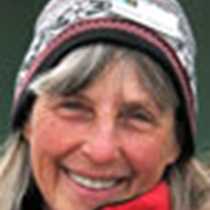LeConte Bay & Petersburg
Eagle watching was the first option for the day as the National Geographic Sea Bird approached her early-morning anchorage at the mouth of LeConte Bay. Several individuals perched on drifting chunks of ice, while others circled nearby. There must have been almost a dozen eagles within close view of the bow, but ice was the top priority for the morning, not eagles.
The trusty Zodiacs transported us into a world of ice bergs and their smaller equivalents, bergie bits and growlers. A high overcast enhanced the deep blue hues of glacial ice that had calved from LeConte Glacier, hidden from view some distance up the fiord. Fabulous shapes rose from the dark sea water. Every now and then a harbor seal poked its head above the surface to curiously study the strange crafts nearby. Marbled murrelets, mottled-brown relatives of the puffins, sat low on the water, their heavy bodies well-suited for a diving lifestyle. Glaucous-winged and herring gulls kept watch from their frozen perches whenever a Zodiac drew near. After winding through these magnificent ice sculptures, we rejoined our mother ship to head for Petersburg.
This important fishing community is not your typical tourist town. There is a great hardware store here and opportunities to buy terrific raingear and fishing tackle.
Our afternoon provided something for everyone. Some boarded helicopters and float planes for aerial views of glacial ice, topography and the adjacent waterways. A fleet of bicycles awaited us at the top of the dock for those who wished to pedal off on their own. A few strode off for an aerobic hike with our wellness specialists. The naturalists offered interpretive walks to see fishing boats along the docks or to visit an enchanting peat bog. Peat bogs, also known as muskegs, are sodden mossy landscapes dotted with dwarfed trees. We explored this acidic environment in search of specialized plants such as the carnivorous sundew. The path led through an interesting forest as well, providing a pleasant contrast to the more open habitat of the muskeg.
Petersburg is also a great spot to simply wander the streets to see what an authentic Southeast Alaskan town really looks like. It was settled by Peter Buschmann, a Norwegian, in 1896. Other Scandinavians followed, and today there is still the flair of their presence here. This site was attractive to early settlers because of the sheltered harbor, abundant year-round fishing, available timber, and the ice from LeConte Glacier nearby.
We all gathered back on the ship in time for a pre-dinner talk by Dr. Fred Sharpe, a research biologist well-known for his extensive work on humpback whales. After our sightings of these charismatic marine mammals last night, his presentation was particularly meaningful.
The ship pulled away from the dock leaving Fred and Petersburg behind, and we sat down to enjoy a meal of ribs and local Dungeness crab brought on board today. What a perfect finish to an eventful day.




